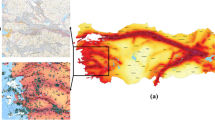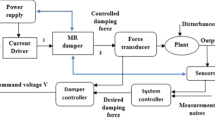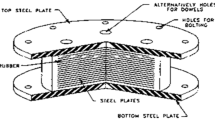Abstract
The method of collaborative work between steel plate anti-wind bearing (AWB) and rubber isolation bearing is proposed to study the vibration reduction effect of isolation structure under stronger wind load, and the function mechanism is explained. Based on a practical project, three kinds of schemes with different isolation layers are put forward, the finite element software ETABS is used for time history analysis, and comparison is made on the seismic response of different isolated structure and aseismic structure. Comparison result shows that the isolation layer with rubber bearing and AWB can work reasonably, but further optimization on the designed parameters is needed. Moreover, the design value of horizontal bearing capacity of lead rubber bearing (LRB) is appropriate to be close to the seismic isolation layer under wind load excitation. Finally, numerical simulation and comparative analysis of shear test of the AWB are conducted. With a very small yield displacement and yield strength over 80% of the set of horizontal bearing capacity, the AWB is validated to satisfy the working conditions which provide the horizontal bearing capacity under normal operating conditions and designed earthquake. The AWB yields and malfunctions, when the maximum displacement is less than the displacement of the isolation layer.
Similar content being viewed by others
References
WANG D, Lü X L, LIU Z P. Shaking table test and comparison analysis for base-isolated high-rise buildings with different aspect ratios [J]. Journal of Vibration and Shock, 2015, 34(16): 109–118 (in Chinese).
WU Y X, WANG Z L, LIN S Z, et al. Seismic response analysis of structure with cooperation of laminated rubber support and wind-resistant support [J]. Journal of Donghua University (English Edition), 2014, 31(4): 411–417.
JIN J M, TAN P, ZHOU F L, et al. Shaking table test study on mid-story isolation structures with viscous damper [J]. Advanced Materials Research, 2012, 226/227/228: 1149–1152.
Code for seismic design of buildings: GB50011-2010 [S]. Beijing: China Architecture & Building Press, 2010 (in Chinese).
GAN M, ZHANG S. Seismic and wind design checking on space structure [J]. Building Structure, 2009, 39(12): 106–117 (in Chinese).
FU J H Design method of aseismic structure and isolation structure in Japan [M]. Beijing: China Architecture & Building Press, 2011 (in Chinese).
Architectural Institute of Japan. Recommendation for the design of base isolated buildings [M]. LIU W G, trans. Beijing: Seismological Press, 2006 (in Chinese).
XIAO C Z, XUE Y T, ZENG D M, et al. Research on design of base-isolated high-rise structure of capital land the loft Chengdu [J]. Building Structure, 2009, 39(6): 93–97 (in Chinese).
TAN P, BU G X, ZHOU F L. Limited wind-resistant research on dynamic reliability of TMD [J]. Journal of Vibration and Shock, 2009, 28 (6): 42–45 (in Chinese).
MOHAMMADI J, HEYDARI A Z. Seismic and wind load considerations for temporary structures [J]. Practice Periodical on Structural Design and Construction, 2008, 13(3): 128–134.
PETTI L, GIANNATTASIO G, IULIIS M D, et al. Small scale experimental testing to verify the effectiveness of the base isolation and tuned mass dampers combined control strategy [J]. Smart Structures and Systems, 2010, 6(1): 57–72.
LI H, LIU D, DU Y F. Research on seismic performance of high-rise isolated building with energy dissipation device [J]. China Civil Engineering Journal, 2010, 43(Sup l): 276–281 (in Chinese).
SHAHABAD M M Z, MIZUNO T, ISHINO Y, et al. Active vibration isolation using negative stiffness and displacement cancellation controls: Comparison based on vibration isolation performance [J]. Control Engineering Practice, 2015, 37: 55–66.
DUTTA S, CHAKRABORTY G. Modeling and characterization of a magneto-rheological fluid based damper and analysis of vibration isolation with the damper operating in passive mode [J]. Journal of Sound and Vibration, 2015, 353: 96–118.
WENG D G, ZHOU Y, ZHAO Y, et al. Isolation efficiency check for multiple friction pendulum bearings using shaking table tests [J]. Journal of Vibration and Shock, 2014, 33(3): 122–129 (in Chinese).
General rule for performance based seismic design of building (abbreviated to general rule): CECS160 [S]. Beijing: China Planning Press, 2004 (in Chinese).
Author information
Authors and Affiliations
Corresponding author
Additional information
Foundation item: the National Natural Science Foundation of China (No. 51578160)
Rights and permissions
About this article
Cite this article
Wu, Y., Huang, J., Yan, G. et al. Optimization of isolation structure under wind load excitation and experimental study of the wind resistant bearing. J. Shanghai Jiaotong Univ. (Sci.) 21, 719–728 (2016). https://doi.org/10.1007/s12204-016-1786-0
Received:
Published:
Issue Date:
DOI: https://doi.org/10.1007/s12204-016-1786-0




